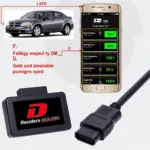As a car owner, you might be wondering about the extent to which you can control your vehicle’s systems using an OBD2 scanner. One common question is whether you can manually turn on the engine fan using this handy diagnostic tool. Let’s dive into the world of OBD2 and engine cooling systems to get you the answer.
Understanding OBD2 and Its Capabilities
OBD2, short for On-Board Diagnostics, is a standardized system that allows external electronics to interface with your car’s computer. It’s the same port mechanics use to diagnose issues, and you can use it with a variety of OBD2 scanners to access information and, in some cases, control certain functions.
While OBD2 is excellent for reading diagnostic trouble codes, monitoring engine performance, and even resetting minor issues, its control capabilities are limited.
Engine Cooling Fan Operation
Before we determine if you can manually trigger your engine fan through OBD2, let’s understand how these fans typically work. In most modern vehicles, the engine cooling fan is controlled by the Engine Control Unit (ECU). The ECU relies on input from various sensors, primarily the coolant temperature sensor, to determine when the fan needs to kick in.
When the coolant reaches a predetermined temperature (usually around 200-230°F), the ECU activates the fan to draw air through the radiator, cooling down the coolant and, in turn, the engine.
So, Can You Manually Control the Fan with OBD2?
The short answer is: it’s unlikely. OBD2 scanners are primarily designed for reading data and diagnosing issues, not for directly controlling components like the engine fan.
The ECU, with its complex programming and safety protocols, usually reserves the right to control crucial functions like fan operation to prevent potential damage from user error. Forcing the fan on when it’s not needed could even negatively impact fuel efficiency.
What Can You Do with OBD2 and Engine Temperature?
While you might not be able to toggle the engine fan on and off at will, your OBD2 scanner can still be incredibly useful for monitoring your cooling system:
- Real-Time Coolant Temperature: Most OBD2 scanners can display live coolant temperature readings, allowing you to keep an eye on your engine’s heat level.
- Diagnostic Trouble Codes: If there’s a problem with your cooling system, such as a faulty fan, thermostat, or sensor, the OBD2 system will likely log a diagnostic trouble code that you can read with your scanner.
- Data Logging: Some advanced scanners allow you to log data over time. This is useful for observing coolant temperature fluctuations and potentially spotting an issue early on.
 Engine Cooling System Components
Engine Cooling System Components
Alternatives to Consider
If you’re experiencing consistent overheating or suspect an issue with your cooling fan, it’s crucial to have it checked by a qualified mechanic. They have the tools and expertise to diagnose the root cause and perform the necessary repairs.
A Word from Jason Parker, Senior Automotive Technician:
“While it’s tempting to tinker with your car’s systems, directly controlling vital components like the engine fan is best left to the professionals. We have the knowledge and experience to diagnose and repair cooling system issues safely and effectively.”
Frequently Asked Questions
1. Can I use an OBD2 app to turn on the engine fan?
Similar to physical OBD2 scanners, apps also primarily focus on reading data and are unlikely to offer direct control over the engine fan.
2. What are the signs of a failing engine cooling fan?
Common indicators include the engine overheating, the fan not running when the engine is hot, strange noises from the fan, and a burning smell.
3. Can I replace a faulty engine cooling fan myself?
While it’s possible, it can be a moderately complex repair. If you’re not comfortable working on your car, it’s best to leave it to a mechanic.
4. Why is my engine overheating even with a working fan?
Several factors could contribute, such as a low coolant level, a faulty thermostat, a clogged radiator, or even a problem with the water pump.
5. How often should I have my cooling system checked?
It’s a good idea to have your cooling system inspected at least once a year, ideally as part of your regular vehicle maintenance.
Explore More Automotive Insights
Interested in learning more about using OBD2 for car diagnostics and maintenance? Check out these related articles:
- Remote Start via OBD2 Code
- Can You Rent an OBD2 Scanner from AutoZone?
- Subaru OBD2 Coolant Temperature Gauge
Understanding your car’s cooling system and how to monitor it with an OBD2 scanner can help you catch potential issues early on and ensure optimal engine performance. Remember, while OBD2 offers valuable insights, it’s best to leave complex repairs and critical system control to the experts.
If you need any assistance or have questions, please don’t hesitate to contact us via WhatsApp: +1(641)206-8880, or Email: [email protected]. Our 24/7 customer support team is always here to help you!

